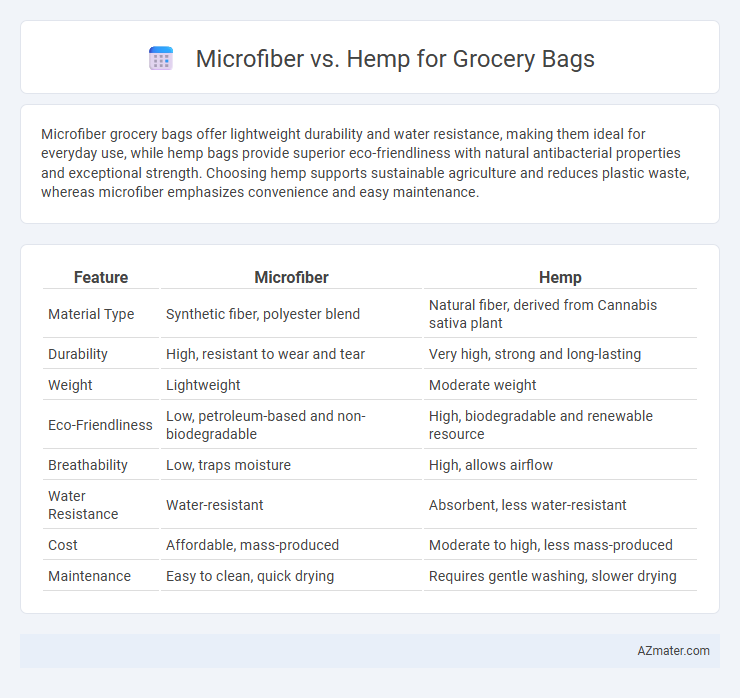Microfiber grocery bags offer lightweight durability and water resistance, making them ideal for everyday use, while hemp bags provide superior eco-friendliness with natural antibacterial properties and exceptional strength. Choosing hemp supports sustainable agriculture and reduces plastic waste, whereas microfiber emphasizes convenience and easy maintenance.
Table of Comparison
| Feature | Microfiber | Hemp |
|---|---|---|
| Material Type | Synthetic fiber, polyester blend | Natural fiber, derived from Cannabis sativa plant |
| Durability | High, resistant to wear and tear | Very high, strong and long-lasting |
| Weight | Lightweight | Moderate weight |
| Eco-Friendliness | Low, petroleum-based and non-biodegradable | High, biodegradable and renewable resource |
| Breathability | Low, traps moisture | High, allows airflow |
| Water Resistance | Water-resistant | Absorbent, less water-resistant |
| Cost | Affordable, mass-produced | Moderate to high, less mass-produced |
| Maintenance | Easy to clean, quick drying | Requires gentle washing, slower drying |
Introduction to Microfiber and Hemp Grocery Bags
Microfiber grocery bags are made from finely woven synthetic fibers, offering lightweight durability, water resistance, and easy maintenance, making them ideal for repeated use. Hemp grocery bags are crafted from natural hemp fibers, known for their exceptional strength, biodegradability, and eco-friendliness, appealing to environmentally conscious consumers. Both materials provide sustainable alternatives to plastic bags, with microfiber focusing on convenience and hemp emphasizing environmental impact.
Material Composition: Microfiber vs Hemp
Microfiber grocery bags consist of finely woven synthetic fibers, primarily polyester and nylon, providing durability and water resistance. Hemp bags are made from natural fibers derived from the Cannabis sativa plant, offering biodegradability and high tensile strength. The contrasting material compositions affect environmental impact, breathability, and overall bag longevity.
Environmental Impact Comparison
Hemp grocery bags have a significantly lower environmental impact than microfiber bags due to their biodegradability and minimal resource-intensive cultivation, requiring less water and pesticides. Microfiber bags, typically made from synthetic polyester or nylon, contribute to microplastic pollution and are derived from non-renewable petroleum products, increasing their carbon footprint. Choosing hemp over microfiber reduces plastic waste and supports sustainable agriculture, making it a preferable eco-friendly option for grocery bags.
Durability and Strength Analysis
Microfiber grocery bags exhibit high tensile strength and resistance to wear, making them durable for repeated heavy use and weight-bearing. Hemp grocery bags, derived from natural fibers, provide exceptional durability with superior abrasion resistance and tensile strength compared to cotton, ensuring longevity even under rough handling. Both materials offer strong options, but hemp stands out for eco-friendly durability, while microfiber excels in water resistance and tear strength.
Weight and Storage Convenience
Microfiber grocery bags are significantly lighter than hemp bags, making them easier to carry without adding bulk to your load. Their compact design allows for efficient folding and minimal storage space in handbags or car compartments. Hemp bags, while sturdier, tend to be heavier and bulkier, reducing storage convenience for everyday use.
Water Resistance and Maintenance
Microfiber grocery bags exhibit superior water resistance due to their tightly woven synthetic fibers, preventing moisture absorption and making them ideal for carrying wet or damp items. Hemp bags, while naturally mildew-resistant and durable, absorb water more readily, requiring prompt drying to avoid mold and odor buildup. Maintenance of microfiber bags is generally simpler as they resist stains and dry quickly, whereas hemp bags benefit from regular air drying and gentle washing to maintain their strength and longevity.
Cost Efficiency and Affordability
Microfiber grocery bags offer high durability at a relatively low upfront cost, making them a popular choice for budget-conscious shoppers seeking long-term use. Hemp bags tend to have a higher initial price due to sustainable cultivation and production processes but provide exceptional strength and biodegradability, leading to cost savings over time through longevity and environmental benefits. Evaluating total cost of ownership, microfiber bags excel in affordability for frequent replacements, while hemp bags deliver superior value via durability and eco-friendly credentials.
Style, Design, and Customization
Microfiber grocery bags offer sleek and vibrant design options with smooth textures ideal for printing detailed logos and colorful patterns, enhancing brand visibility. Hemp bags provide a natural, rustic aesthetic with a durable, coarse weave that appeals to eco-conscious consumers seeking authenticity and sustainability in style. Customization on microfiber allows for intricate, high-resolution graphics, whereas hemp supports eco-friendly dyes and embossing techniques for a handcrafted look.
Biodegradability and End-of-Life Options
Hemp grocery bags offer superior biodegradability compared to microfiber, decomposing naturally within months without releasing harmful microplastics. Microfiber bags, typically made from synthetic polymers like polyester, persist in landfills and contribute to long-term environmental pollution. End-of-life options for hemp bags include composting and recycling, whereas microfiber bags often require specialized recycling facilities that are less accessible, leading to increased landfill accumulation.
Which Grocery Bag Material is Best?
Microfiber grocery bags offer durability, water resistance, and lightweight convenience, making them ideal for quick trips and easy cleaning. Hemp bags provide superior environmental benefits with their biodegradability, strong fibers, and natural resistance to bacteria, appealing to eco-conscious consumers. When choosing the best grocery bag material, consider durability, sustainability, and ease of maintenance to match your lifestyle and environmental priorities.

Infographic: Microfiber vs Hemp for Grocery Bag
 azmater.com
azmater.com